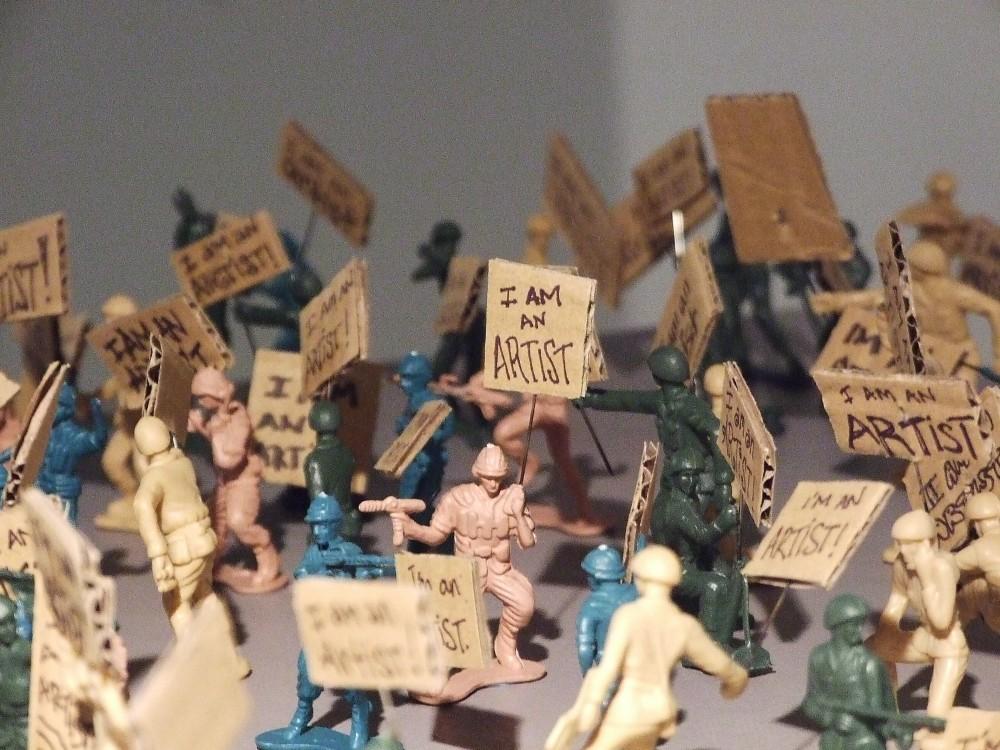The aesthetics of public space

In this Civic Studio exhibit, toy soldiers represent artists on a cultural battlefield
Mar 24, 2011
Before ArtPrize brought giant sea serpents to our rivers and wooden war pigs to our sidewalks, one member of the Grand Rapids art community wished to explore the role of art in the public sphere.
As a professor of philosophy at Calvin College in the 1980s, Lambert Zuidervaart began developing an idea for a book that would answer questions like, “What is art like?” and “What is its role in society?”
The task was much bigger than he first expected — it took more than 20 years of research and resulted in two books.
Zuidervaart, who now teaches philosophy at Toronto’s Institute for Christian Studies, returned to Grand Rapids on March 17 for a lecture and the release of his latest book, “Art in Public: Politics, Economics, and a Democratic Culture.”
“I thought Grand Rapids was a fitting place to release the book because it’s where the ideas took shape – during my time at Calvin College and at the Urban Institute for Contemporary Arts,” said Zuidervaart, who served as the president of the Urban Institute for Contemporary Art from 1994 to 1998.
In the book, he defines “art in public” as any art that receives some type of government support and is available to a wide audience.
Some things Zuidervaart discusses in his book include using art to experience new things, as well as using it to bring change to society.
The ideas Zuidervaart presents in the book lead him to conclude, “A democratic society needs art in public, and art in public needs us.”
The lecture and book release at the Grand Rapids Art Museum were part of a two-day event focusing on Zuidervaart’s new manuscript.
On March 18, Zuidervaart and Paul Wittenbraker of the Grand Valley State University Department of Art and Design led a symposium at the UICA that focused on the question, “What does art need, conceptually and practically, to serve its public function?”
Zuidervaart said in order to serve its function, art in public needs help from three major societal institutions: the economy, the government and the public.
During the symposium’s intermission, Wittenbraker invited audience members to the UICA’s gallery where a Civic Studio exhibit featured visual representations of the main arguments from “Art in Public.”
Created by Wittenbraker in 1999, Civic Studio is a site-based public art project offered as part of the Visual Studies emphasis in the GVSU Department of Art and Design. It aims to expand the relevance and value of art in everyday public life through interaction with the local community.
“I think (the exhibit) is a great aid in helping people understand Lambert Zuidervaart’s new book,” said Civic Studio member Amber Stout. “For visual people, seeing his ideas in an actual form instead of in writing is a great way of initiating conversation and seeing the issues from a different perspective.”
Another concept Zuidervaart covers in his book is the idea that everyone has the right to participate in the arts.
“Often society sees art in public as things such as the spectacle pieces of ArtPrize, and likewise, artists are considered to be those who paint, draw, etc.,” said Civic Studio member Christie Westmaas. “I think our view of art would shift drastically if things such as farmers markets, movies, music or park benches were included in the idea of art in public, or if we were to include philosophers, scientists, or all citizens for that matter to be artists. If art is seen in that way, then I believe it to be quite obvious for why public art is important in society today.”

























